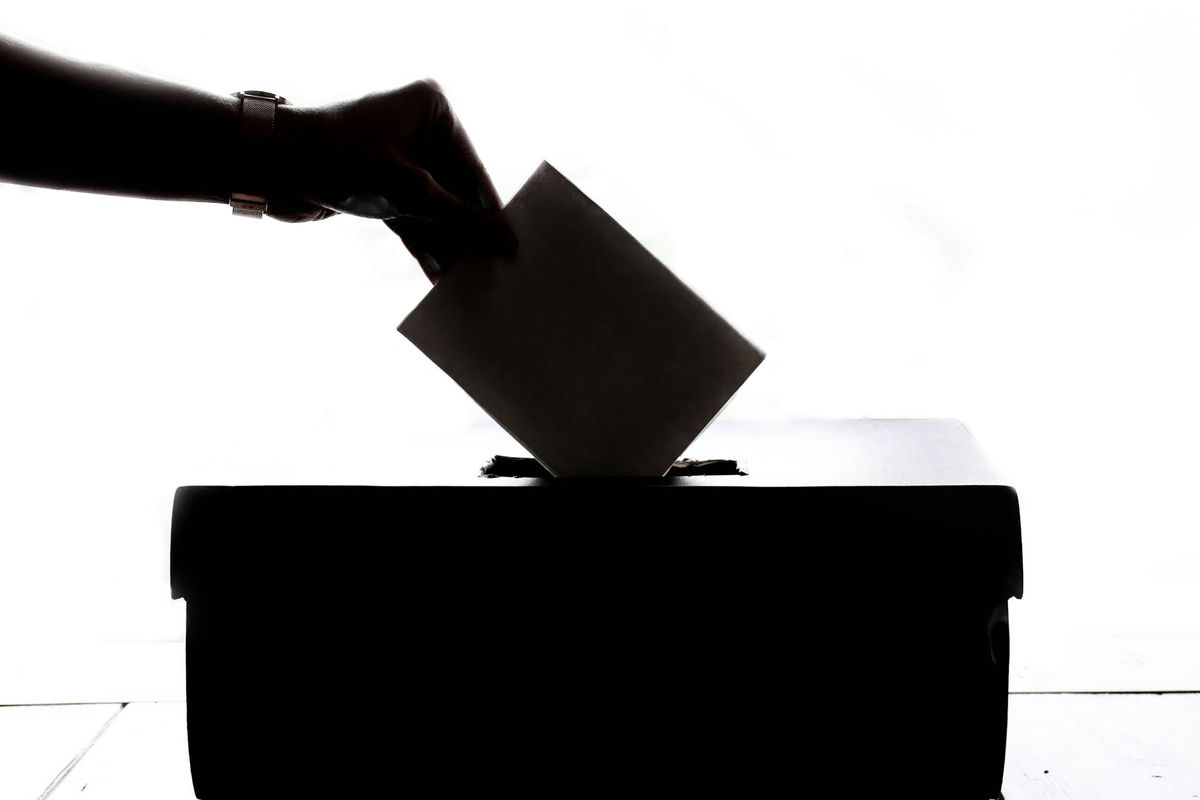3 kinds of people benefit from Election Day being on a Tuesday. They're probably not you.

What are you doing on Election Day?
No, what are you doing on Election Day besides balling yourself up in a Snuggie under a heat lamp with two dozen cheese sticks, listening to Cat Stevens, and whispering "It'll all be over soon." as you rock back and forth on your couch?
If you're like millions of other Americans — you're going to work.
For some, doing one's job on Election Day is a great distraction that makes it possible to fill out a color-coded meeting calendar and chat up Chris from accounting while pretending that the world isn't either coming to an end or becoming, at the least, an interesting "Battlestar Galactica" B story.
The perils of low turnout. GIF from "Battlestar Galactica."
For others, going to work on Election Day makes it damned near impossible to vote.
Estimates show that only 57.5% of eligible voters voted in 2012. That's lower than most other countries in the developed world. Belgium, guys. Belgium is kicking our ass.
There's a pretty simple reason for this: Election Day is on a freaking Tuesday, a scheduling decision that made perfect sense in 1845, when America's election days were standardized. Sunday was the sabbath, so traveling that day to make it to your polling place on Monday was out. And farmers had to go to market on Wednesdays. Back then, lots of people were farmers and many were uber-religious, so Tuesday it was!
Now, it's 2016. Most of us don't farm anymore. And even the more God-inclined among us tend to use a car on Sundays. Yet, Election Day remains on a Tuesday, the least distinctive, and arguably most depressing, day of the work week.
Fortunately, there's a really easy solution that could vault us right back ahead of Belgium!
We could make Election Day a national holiday.
Just give everyone the day off already. President Obama thinks we should do it. Bernie Sanders thinks we should do it. And if Bernie Sanders thinks we should do it, Donald Trump will probably pretend to think we should do it too.
There are plenty of reasons to do it. It makes democracy more democratic, for one. It's humane to people who work long hours at demanding jobs, for another. Not to mention it associates voting — a boring activity — with chill vacation vibes. Voting would become something people look forward to.
Most Americans don't benefit from the current election model where we all vote on a Tuesday. Only a few of us do. For the most part, those of us who do benefit from it don't need the help getting to the polls.
Mostly because our current election model really only benefits people like...
1. Extremely rich people
Make that money fly! Photo via iStock.
For America's super rich — your Mark Cubans, your Koch Brothers, your Elon Musks — every day is a national holiday, including the second Tuesday of November.
Consider the following mega-rich people possibilities:
A. They don't have a job, because they're so rich they don't have to work.
B. They do have a job, at which they are the boss and, therefore, can do whatever they want whenever they want.
Right now, it is insanely easy for bazillionaires to vote. And that's OK! Rich people should vote. But it should be just as easy for non-rich people to vote. If not, you get stuff like the slow phase out and (mercifully temporary) repeal of the estate tax and tax deductions for yachts with sleeping quarters.
I'm not saying those things aren't good policy. What I'm saying is, they're atrocious policy designed, self-servingly, to benefit a cohort that is least in need of a break and has disproportionate access to the levers of power. The only way for regular people to get their priorities taken seriously is to increase their numbers at the ballot box.
But regular people gots to work, bro. They can't get to the polls.
So let's give them the day off.
2. Writers who work from home and have their polling place in the building across the street.
Oh boy, is it ever easy for me to vote! You have no idea.
Two thumbs up for my face. Photo by Eric March/Upworthy.
All I have to do is take a leisurely 20-foot stroll to the school I can see from my window, wait in line for less than five minutes, grab my sticker, and shuffle right back to my laptop. Not only that, my boss probably won't even know I've gone anywhere because we don't work in the same room together.
A 2005 study published in the Journal of Politics — that reviewed data from the 2000 presidential race and a local election in Atlanta — found that predicted probability of voting goes down the further you have to travel to get to your polling place. For voters without a vehicle, the drop-off is even greater.
For people who have a long commute on top of a job where they don't get a lunch break, the prospect of having to fight the after-work rush in an hours-long line to vote, and the whole process starts to seem a whole lot less rewarding.
I've made it pretty clear who I hope does not become president. Maybe you disagree with me. Or, you agree with me just this once, but plan to not agree with me next time. And it's so easy for me to vote, guys. And I'm part of the so-called media elite! I'm everything many people are saying is wrong with America.
It should be as easy for you to cancel out my vote as it is for me to cast it.
You can't do that if you have to work.
So let's make sure no one has to work on Election Day.
3. Lastly, our current election model benefits people who want fewer people to be able to vote.
If you believe that democracy works better when more people participate, then letting everyone take the day off on Election Day probably seems pretty rad. If, however, you're worried that your political beliefs are so unpopular that the only way to ram them through into law is by forcing people who might vote against them to work on Election Day, then the status quo is pretty hunky-dory.
North Carolina Governor Pat McCrory signed a voter ID law in 2013 that was struck down by a federal court for its explicit intent to disenfranchise black voters. His face is huge in this picture. Photo by Chip Somodevilla/Getty Images.
If you're a fan of Voter ID laws, which solve a voter fraud problem that doesn't exist while also — would you believe it! — depressing the young and non-white vote, then the more people who can't get to the polls because they're trudging to work on Election Day, the better.
If you like moving polling places away from where black people live, then you probably don't want them having the day off to vote at a leisurely clip on Election Day either.
If you're a fan of restricting early voting hours, you're probably also a fan of keeping baristas across America working two shifts all through early November to make sure they can't get to the polls either.
If, however, you believe that people have the right to vote and should be able to exercise that right easily, regardless of race, religion, gender, sexual orientation, or, most critically in this case, employment status, then your preference should be clear...
...an all-day, nationwide snow day on Election Day.
There's really nothing stopping us from doing this, people.
Our Election Day holiday doesn't have to be dry and boring either. We could make it a real celebration! Start a tradition where we all get our mothers cards, or bake pecan pies, or listen to the patriotic hits of Kate Smith that day, or something. Hell, swap it with Columbus Day! It's around the same time of year, it could easily be adopted in all states, not just some, and it doesn't celebrate the derivative wanderings of a genocidal maniac!
Voting is too important for only slightly-more-than-half of America to do it. It's too important for only the wealthy, the retired, the unemployed, and the people with cushy media jobs to partake in. It's too important to not require a day off to make sure everyone gets a chance to make their voice heard.
Make Election Day a national holiday. Who's with me?




 Newborn's first cry marks a fresh beginning.
Newborn's first cry marks a fresh beginning. Newborn baby.
Newborn baby.


 Woman in denim jacket covers face with sleeve, standing outdoors with blurred background.
Woman in denim jacket covers face with sleeve, standing outdoors with blurred background. Woman with outstretched arms in a sunlit field, enjoying the outdoors.
Woman with outstretched arms in a sunlit field, enjoying the outdoors. Lush forest with vibrant green and orange foliage in soft, misty sunlight.
Lush forest with vibrant green and orange foliage in soft, misty sunlight. Friends laughing and drinking coffee at a cozy cafe table.
Friends laughing and drinking coffee at a cozy cafe table. Woman with curly hair in sunlight, eyes closed, wearing a purple top.
Woman with curly hair in sunlight, eyes closed, wearing a purple top. Man smiling with hand over face, standing outdoors against a blue sky background.
Man smiling with hand over face, standing outdoors against a blue sky background. Hand painting a still life on canvas with blue and orange tones.
Hand painting a still life on canvas with blue and orange tones. Woman sitting on a chair in the water, writing in a notebook at sunset.
Woman sitting on a chair in the water, writing in a notebook at sunset.
 Women walking down a street.Image via Canva Photos.
Women walking down a street.Image via Canva Photos.  Woman aware of her surroundings in a parking garage. Image via Canva Photos.
Woman aware of her surroundings in a parking garage. Image via Canva Photos.
 "You're hilariously brilliant at everything you hate."
"You're hilariously brilliant at everything you hate."  "Bridget is authentically herself…and triumphs in her own way."
"Bridget is authentically herself…and triumphs in her own way."  "They're written in some curious language that I can't really understand."
"They're written in some curious language that I can't really understand."